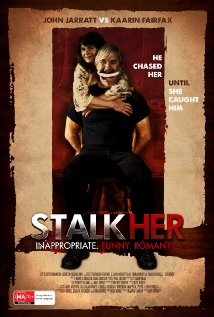
STALKHER
Australia, 2015, 90 minutes, Colour.
John Jarrett, Kaarin Fairfax, Robert Colby.
Directed by John Jarrett and Kaarin Fairfax.
The play on words in the title seems obvious but it is surprising that this has not been used so much more in the past. It sums up of the action of this film – but not quite because there is a twist that might become more and more apparent as the action goes on.
This is a joint project by the two actors, John Jarrett and Kaarin Fairfax, with the screenplay, performances and co-directing.
There are some scenes in a hospital and, towards the end, in a supermarket, but this is basically a two-hander, the action taking place within the confines of a suburban house. Two-handers are always a challenge for the audience, accepting that the action and dialogue would be confined to the two characters, requiring concentration, offering little relief. Attention requires strong and dramatic dialogue as well as powerful performances.
This time the performances are forceful in their way. We have seen John Jarrett do this kind of tough and rough and many audiences will remember his performances In the Wolf Creek films. Kaarin Fairfax has the more nuanced role. One of the difficulties for concentration is that the dialogue is expletive-filled, tiresome at the best of times, but too easy a copout for more dramatic and intense writing.
It is established that Kaarin Fairfax is a nurse in a hospital and John Jarrett’s character is a pharmacist. There are some flashbacks reinforcing this. But, of course, the question is are the characters what they seem. When a masked man intrudes into a house seemingly to terrorise the occupant, and the occupant overcomes the intruder, we have a set up for cross-interrogation, explorations of character – and further revelations.
In some ways, the toing and froing (both realistic and, sometimes, in the imaginations of the characters) has some fascination – but the danger is that becomes repetitious, and repetitious.
There is a twist but, with insinuations, invective and physical violence, many audiences will see is coming before the revelation. This twist has been used in other stories, most particularly and more effectively in the film version of Neil LaBute’s?, Some Velvet Morning.
Which means that the film does have some interesting aspects but, as for both the central characters, it is something of an ordeal.
1. The impact of the film? As drama? As psychodrama? As role play?
2. The interiors, hospital, the house, the variety of rooms? The supermarket?
3. The title, with reference to Jack and to Emily? The interplay between the two?
4. The two-hander, the strength of the dialogue, the reliance on expletives rather than dramatic writing?
5. The situation, Emily at the hospital, the intruder, masked, getting to the house, car, Emily taking control, control moving back and forth, violence, sexual interaction?
6. The film and its comment on behaviour? Male, female? Sexual language, violent language?
7. Changes in power, the different perspectives of the flashbacks, Emily’s behaviour at the hospital, with the doctors, possible liaisons, and the variety of ways of seeing Jack’s behaviour, and in the imagination of the two protagonists?
8. The scenes, realistic?
9. The reversal of roles? Audiences realising that this was role play? What Emily wanted and needed? What Jack wanted and needed? The relationship
between the two? The significance of game-playing?